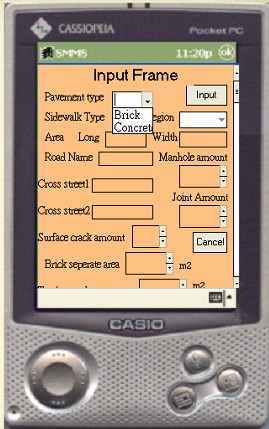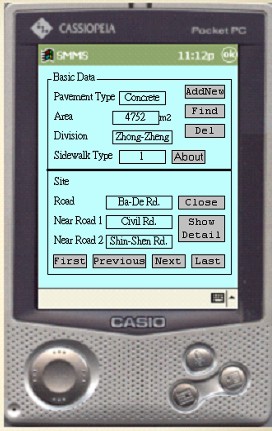
engineering & technology publications
ISSN 1759-3433
PROCEEDINGS OF THE FIFTH INTERNATIONAL CONFERENCE ON ENGINEERING COMPUTATIONAL TECHNOLOGY
A Portable Maintenance Management System for Sidewalks
1Department of Civil Engineering, National Taipei University of Technology, Taipei, Taiwan, R.O.C.
2Taiwan Construction Research Institute, Taipei, Taiwan, R.O.C.
A sidewalk is one of the facilities, which is important for each citizen's livelihood. The facility of the sidewalks not only provides a walkway for people but is also a key factor of a city's development and improvement [2]. If roads are the blood vessels transporting traffic in all directions, then sidewalks are the capillaries in each city. The main functions of sidewalks not only provides people with walkways but also supplies a utility of the environment. So an appropriate sidewalk system is a sign of modernization and advancement for each city [3].
This research investigates several using influence factors, that were collected from papers and reality investigations. This research uses scientific tools including the Delphi method, the analytic hierarchy process, and fuzzy theory to analyze and establish a preliminary evaluation model for sidewalk maintenance management. In order to use this model pragmatically, this research also establishes a portable system. With this portable system, inspectors can use a PDA to investigate the problems of sidewalks 'in the field' and can collect these problems to input them into the system. Then this system can calculate all the investigation data of sidewalks to sort out what section of a sidewalk should be repaired first. So, through this prototype sidewalk maintenance management system, sidewalks can be repaired and constructed made with an optimum solution.
The use of this maintenance system at construction job sites can help the inspectors better inspect sidewalks. This can lead to an appropriate and consistent decision treatment. The productivity and quality of inspection can be significantly improved by providing inspectors with the consistent rehabilitation decision criteria. The major advantage of this prototype PDA program is to accept the inputs from the existing field conditions and immediately recommend an appropriate decision immediately at the construction job site.
- 1
- Lee-kuo Lin and Hosin Lee, "Development of a Portable Inspection Expert System for Rehabilitation Inspection in Salt Lake City", Journal of Civil Engineering System, Vol. 13, PP185-202,1996,12. doi:10.1080/02630259608970197
- 2
- Lee-kuo Lin and Che -Jeng Cheng, "Plan and Construction Management of Wan-Ban Railway Underground Project", The 9th Conference of Construction Engineering and Management, ppE3-06-1-10, 2005,05.
- 3
- Chen-you Jian, "The development of sidewalks maintenance management system", Master Thesis, National Taipei University of Technology, Taipei R.O.C., 2003.07.
purchase the full-text of this paper (price £20)
go to the previous paper
go to the next paper
return to the table of contents
return to the book description
purchase this book (price £105 +P&P)

